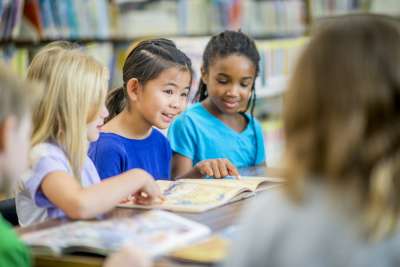Readers Theatre
by Sam Sebesta
Readers Theatre is an oral reading activity that invites children to "become" the characters in favorite books and stories. With practice and careful coaching, Readers Theatre helps pupils improve their reading skills and learn to engage with texts in a unique, enjoyable and gratifying way.
What Is Readers Theatre?
Readers Theatre is an oral reading activity that closely resembles radio drama. Two or more readers stand or sit side by side, usually in a semicircle, holding scripts and reading their parts to portray characters, narration or exposition. Physical movement is minimal. Instead, speech conveys the action.
Why Use Readers Theatre?
You can really motivate pupils with Readers Theatre. It gives participants a purpose for repeated reading, leading to fluency. Internalized, such fluency transfers to effective silent reading as well. Readers Theatre lets pupils apply comprehension skills, including author's purpose, character traits, mood and theme. According to drama expert Nellie McCaslin, Readers Theatre is "a way of enjoying good literature through guided study, a mutually agreed-upon interpretation and clear and expressive oral reading."
Where to Get Scripts
You may obtain play scripts from library drama collections, readers theatre script services and reading-text series. Preparing your own scripts, however, is another exciting option.
Begin with good children's literature that has lively dialogue. Convert a passage into a play script by indicating speakers and dialogue (omit the "he saids" and "she saids") and by adding, when necessary, a narrator to explain the situation or action. Your script might look like this one based on Poppleton by Cynthia Rylant.
TeacherVision also has some readers theatre scripts:
- The Drinking Gourd
- Floridious Bloom and the Planet of Gloom
- The House of Sixty Fathers
- Johnny Tremain
- Journey Home
- Karate Katie
- Little House on the Prairie
- The Miraculous Journey of Edward Tulane
- Rufus and Friends: Rhyme Time
- Unite or Die: How 13 States Became a Nation
- The Witch of Blackbird Pond
- Zia
Some teachers like to place clear plastic, such as acetate used for overheads, over a page of dialogue. Then pupils can underline their speeches and the print becomes a script. This technique also provides good practice in recognizing dialogue and narration.
Readers Theatre can also include nonfiction (such as history), descriptive science and biography. Divide the non-dialogue text among pupils. Then have them present it in Readers Theatre style to bring clarity and purpose through oral interpretation.
Three Tips for Readers Theatre Success
1. Practice, practice, practice!
Instead of passing out scripts and asking pupils to read aloud at sight, send scripts home and encourage individual practice. Or have small groups rehearse alone or with your help.
Once the players are assembled, have them read through the script several times for rate fluency before working on interpretation. This practice builds confidence and also helps develop reading skills.
2. Coach readers to improve oral interpretation.
Without guidance and encouragement, Readers Theatre may be as lifeless as the best-forgotten round-robin reading. Aim your coaching specifically at a character's emotions and intentions. For example, you might say, "Fillmore has sly intentions, so use your voice to show his sly intentions, even in his first speech."
Specific suggestions help far more than generalities, such as, "Read with more expression." Emphasize the contrast between characters. For instance, Poppleton is kind but gullible, while Fillmore is sly and scheming. Seeking out contrasts has carryover, of course, to pupils' understanding and enjoyment of all their literary reading.
3. Consider inviting an audience.
Sometimes an audience enhances performance and pride. Sometimes an audience undermines developing skills and confidence. If you opt for an audience, keep it small. Have three or four groups in a classroom take turns performing for one another.
In no case should the audience possess the script. Their role is to listen and respond, not to follow along. In fact, an audience may need coaching, too, to encourage players with positive, perceptive responses. Readers Theatre is a great way to turn your pupils on to the joy of literature. To find out more about Readers Theatre, check out our list of resources.
Further Reading
Buckley, Marilyn Hanf. "Oral Language: A Curriculum Yet to Come." English Journal 84 (1995): 41-45.
Educational Testing Services. Listening to Children Read Aloud. Report No. 23-FR-04. Washington, DC: Educational Testing Services, 1995.
McCaslin, Nellie. Creative Drama in the Classroom, 5th edition. New York: Longman, 1990.
Naylor, Phyllis Reynolds. Shiloh. New York: Macmillan, 1991.
Readers Theatre Script Services, P.O. Box 178333, San Diego, California 92117.
Rylant, Cynthia and Mark Teague, ill. Poppleton. New York: Scholastic, 1997.
Samuels, S.J. "The Method of Repeated Readings." The Reading Teacher 50 (1997): 376-381.
Spinelli, Jerry. Maniac Magee. New York: Little, Brown, 1990.
Young, Terrell A. and Sylvia Vardell. "Weaving Readers Theaters and Nonfiction into the Curriculum." The Reading Teacher 46 (1993): 296-306.













